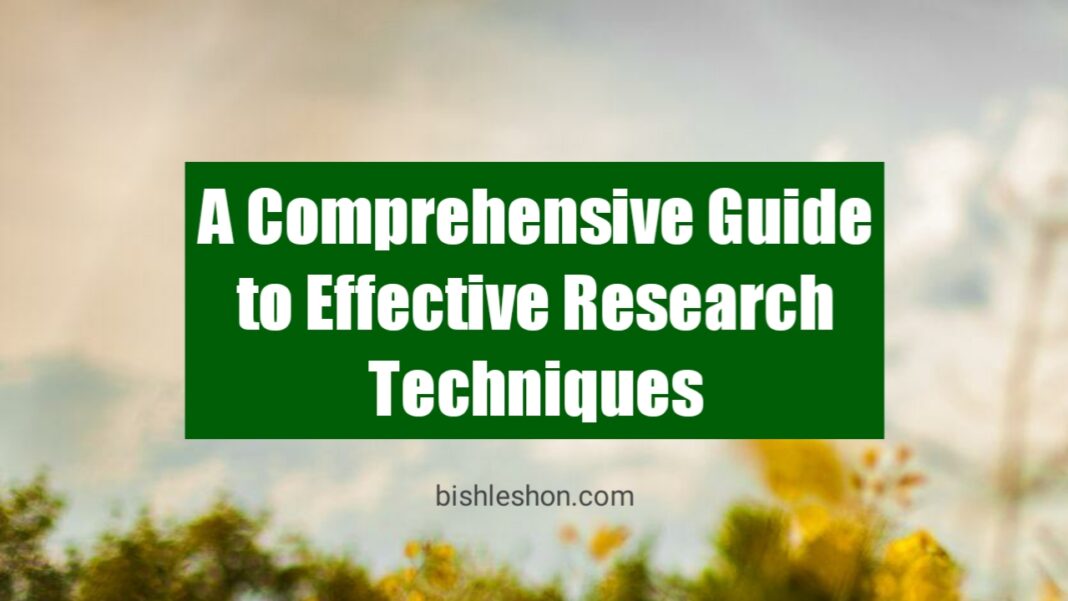Research is a crucial part of academics, business, and personal projects. It involves the collection and analysis of data and information to support conclusions and decision making. Effective research techniques can help you find relevant and reliable sources, analyze data, and present your findings in an organized and compelling manner.
This article will provide a comprehensive guide to effective research techniques, including the following subheadings:
- Defining your research question and purpose
- Selecting appropriate research methods
- Identifying and accessing relevant sources
- Analyzing and organizing data
- Presenting your findings
Defining your research question and purpose
The first step in effective research is to define your research question and purpose. A well-defined research question provides direction and focus for your research and helps you stay on track. Your research question should be specific and relevant to your topic and should align with your research purpose.
Your research purpose is the reason why you are conducting the research. It may be to gain a deeper understanding of a subject, to test a hypothesis, or to provide solutions to a problem. Understanding your research purpose will help you determine the type of research method to use and the type of data to collect.
Selecting appropriate research methods
There are several types of research methods, including qualitative and quantitative research. Qualitative research is exploratory and focuses on the subjective experiences and perspectives of individuals. It is often used to gain a deeper understanding of complex issues and may include methods such as interviews, focus groups, and observation.
Quantitative research is more structured and focuses on numerical data and statistical analysis. It is often used to test hypotheses and measure the impact of interventions. Quantitative research may include methods such as surveys, experiments, and observational studies.
When selecting a research method, consider the following factors:
- Research question and purpose: Your research question and purpose will help you determine the type of research method to use.
- Data availability: Consider the type of data you need to answer your research question and whether it is available and accessible.
- Time and resources: Some research methods require more time and resources than others. Consider the constraints of your project and select a method that is feasible and practical.
Identifying and accessing relevant sources
Once you have selected your research method, it’s time to identify and access relevant sources. There are many sources of information available, including books, journal articles, government reports, and online databases. When accessing sources, consider the following factors:
- Reliability: Ensure that your sources are reliable and credible. Consider the author’s credentials, the publisher, and the date of publication.
- Relevance: Ensure that your sources are relevant to your research question and purpose.
- Bias: Consider any potential biases in the sources you access.
To access relevant sources, you may use library databases, Google Scholar, or specialized databases for your field of study.
Analyzing and organizing data
Once you have collected your data, it’s time to analyze and organize it. Data analysis involves the interpretation of data to gain insights and answer your research question. The type of data analysis you perform will depend on the type of data you have collected and the research method you have used.
Quantitative data analysis may include statistical techniques such as regression analysis, chi-square test, and t-test. Qualitative data analysis may include coding, categorizing, and thematic analysis.
Organizing your data can help you to make sense of it and identify patterns and trends. You may use tools such as spreadsheets, mind maps, or Presenting your findings
Presenting your findings
Finally, it’s time to present your findings. The way you present your findings will depend on the purpose of your research and the audience you are presenting to. In general, you should present your findings in a clear and concise manner, using visual aids such as graphs, tables, and charts to support your arguments.
When presenting your findings, consider the following:
Audience: Consider the background, expertise, and interests of your audience when presenting your findings.
Objectivity: Present your findings objectively and avoid personal opinions or biases.
Limitations: Acknowledge any limitations of your research and the implications for your findings.
Conclusion
In conclusion, effective research techniques are essential for conducting successful research projects. By defining your research question and purpose, selecting appropriate research methods, identifying and accessing relevant sources, analyzing and organizing data, and presenting your findings, you can ensure that your research is thorough, accurate, and well-presented.



 For all latest articles, follow on Google News
For all latest articles, follow on Google News